I’ve never met a potato I didn’t like.
I’d eat them for every meal if I could, and I usually have to force myself to think of alternative side dishes, because in my world, potatoes go with everything. (This may have to do with the fact I grew up in Idaho? I can’t help myself.)
Therefore, it’s only logical they’d be one of my most-favorite things to grow in the garden. I get all-sorts of giddy when I’m pulling pounds and pounds of them out of the soil and piling them into the wagon to be taken into the house.
You haven’t lived until you’ve eaten tender new potatoes, fried in a bit bacon fat and smothered in sour cream and chives. Grocery store potatoes don’t even remotely compare. Not even close.
I’ll stop waxing poetic about potatoes if you promise to try growing them at least once. Sound like a deal?
Let’s talk details so you know exactly how to make this potato-gig happen.
By the way, if you prefer listening rather than reading, check out my podcast episode on growing potatoes.
Growing Potatoes: What You Need to Know
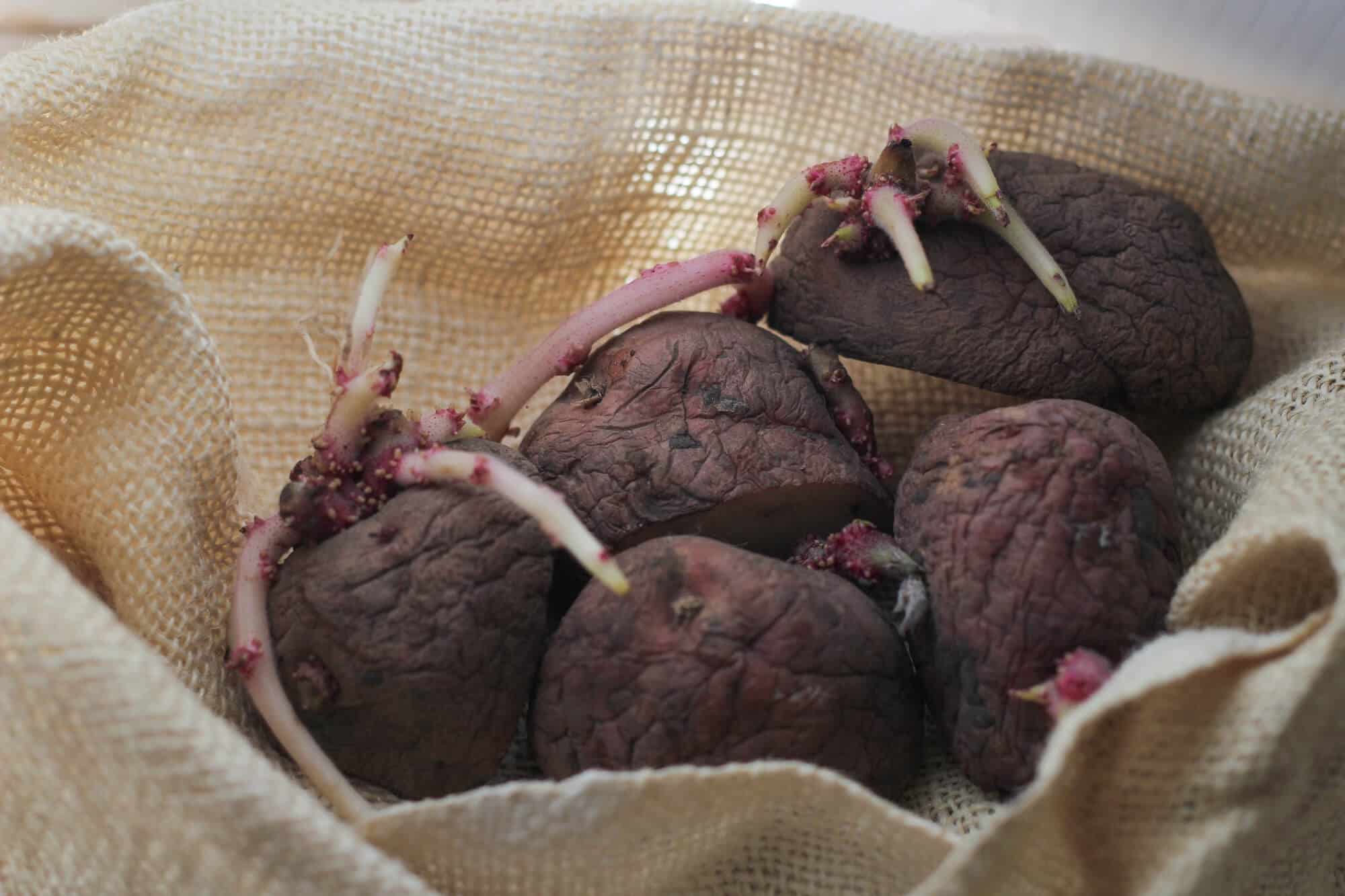
Start with Seed Potatoes:
Seed potatoes– you need em. And you’ll want “official” seed potatoes– not sprouted, shriveled grocery store potatoes. Using proper seed potatoes ensures you won’t be introducing any diseases into your garden, and you can find some pretty cool varieties that’ll grow better in your climate. There are a variety of online seed potato suppliers (Google ’em) or check your local nursery or farmer’s market for organic seed potatoes.
I get seed potatoes from our local organic garden store each year. Yukon Golds are my #1 absolute favorites, but I usually grow several different kinds each year, including Kennebec, Red Pontiac, German Butterball, All Blue, and/or some various purple ones (whose names I can’t remember). The varieties you pick will depend on your availability and climate– I do recommend picking options that aren’t easily available in your grocery store, though. I’ve found them to generally be more delicious, and it’s more satisfying to grow something you couldn’t get otherwise.
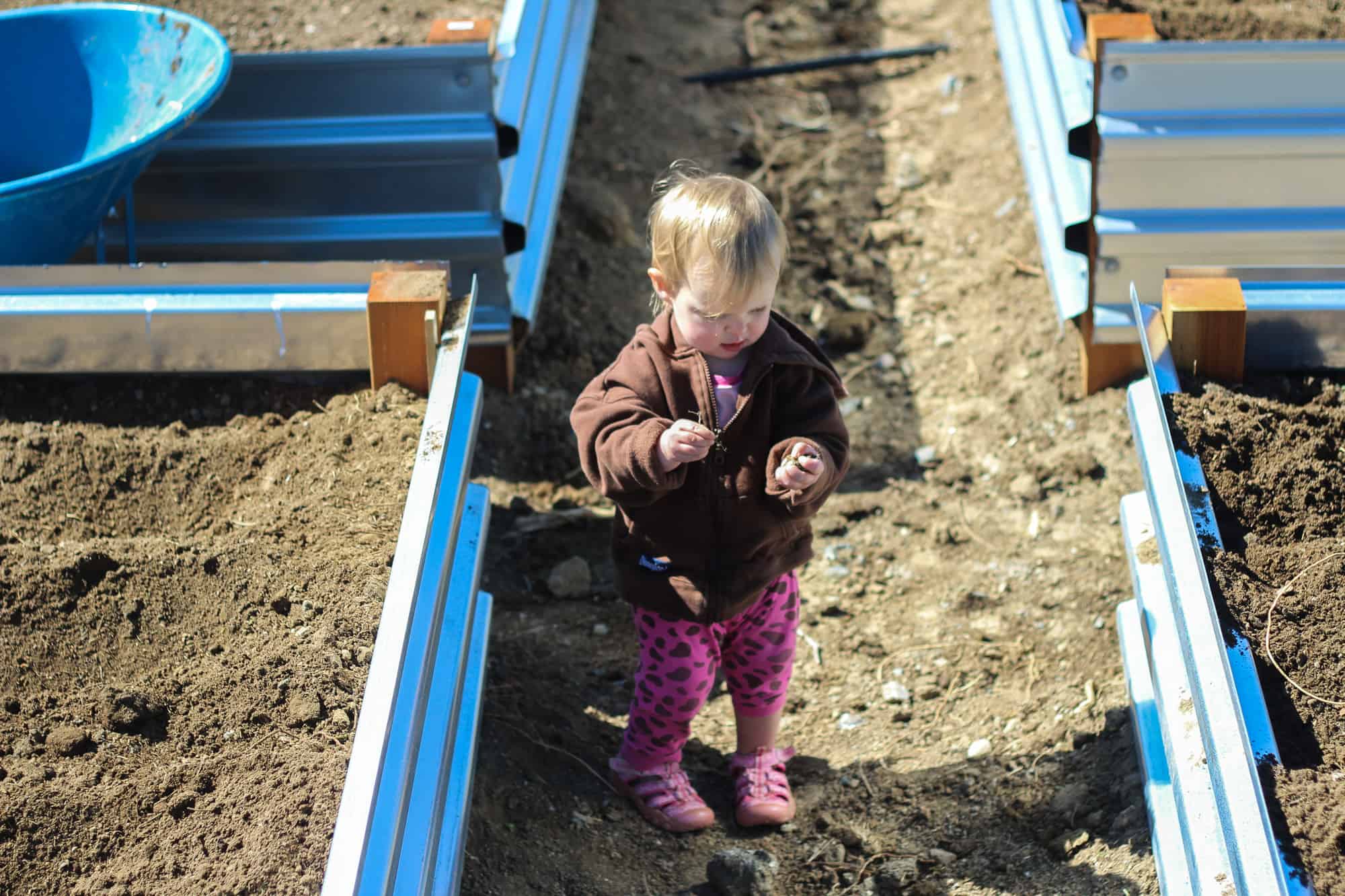
When/Where to Plant Potatoes:
I generally buy my seed potatoes, and then get distracted from planting them for a week or so. But my procrastination is actually beneficial here. Chitting (aka pre-sprouting) your seed potatoes can give your plants a head start for healthy growing. (You just might want to let the sprouts get *quite* as long as they are in my photos…. whoops.) I also cut up the larger potatoes to make them stretch a bit further– however if you do this, make sure to have at LEAST two eyes per piece. Also, cure the cut pieces afterwards by letting them sit for at least 24 hours in a cool, dry place so that their exterior surface will be hardened. (And they’ll be less likely to rot once you plant them.)
You can plant your potatoes a few weeks before your last frost date in the spring. Potatoes love to start growing in cool weather. Just make sure the soil has both thawed and dried out a bit.
Since potatoes are a root crop, plant in loose, compost-rich soil with good drainage.
A few more potato reminders:
- Plant your potatoes in full sun.
- Plant them where you have not recently grown either tomatoes or potatoes (crop rotation is a MUST!).
- When planting, space them at least 1 foot apart, and have your rows about 3 feet apart.
How to Properly Plant Potatoes:
The classic way is the ‘trench and hill method‘: Start by making rows of shallow trenches, with the mounds of soil from those trenches in between the rows. Place the potatoes (cut side down and/or sprout side up) in these trenches and cover with loose soil. As your potato plants grow, hill up the excess soil around the plants, so that you not only get MORE potatoes, but you are also protecting your potatoes from the sun (sunlight makes them green). Keep mounding soil up around your potato plants until there is at least 1 foot of soil hilled up around each plant. I’m planting mine in my new raised beds this year— I’ll keep ya posted how it goes.
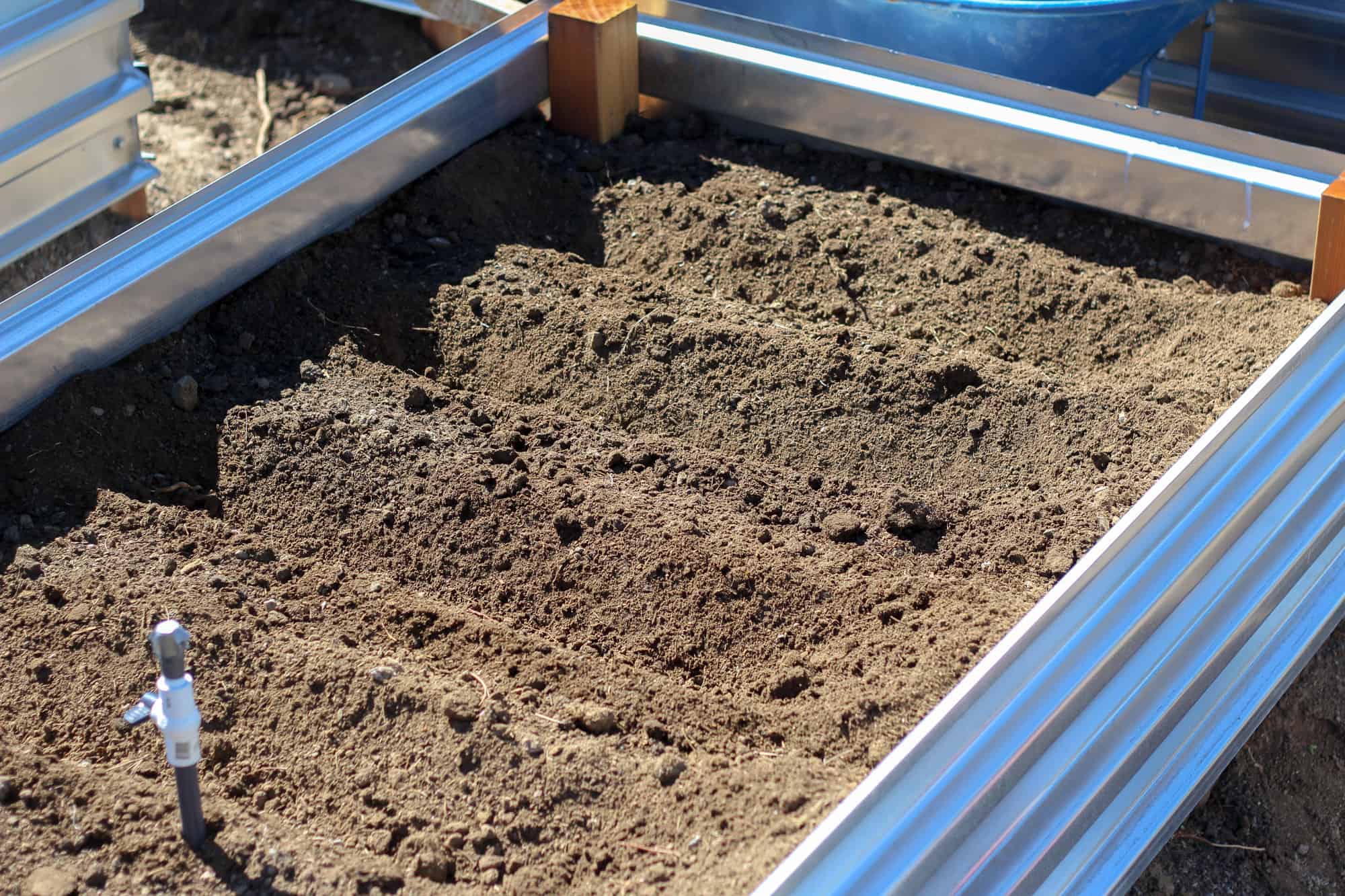
If you get tired of trying to find enough soil to hill up on your potato plants, you can switch to mulch instead, after you have about 6″ of soil. Mulch also helps keep the soil weed-free and cool.
Alternative Methods of Growing Potatoes:
There are many creative alternative methods of potato planting if you want to think outside the box. The ‘trench and hill method’ is the classic way, and many gardeners claim the best way, however, if you don’t have the space or soil for the classic method, here are a few other options:
- Potato towers: I’ve seen pallet towers, fancy wooden towers, and even recycled tires for potato towers. You basically add sides to the tower and more soil as the plants grow. If you have poor soil or limited space, this might be a good option for you.
- Potatoes in grow bags: You can grow potatoes in burlap bags or grow bags (like this one on Amazon– affiliate link). You start with the bags rolled down, and then bring the sides up and add dirt as the potatoes grow. This method might work if you need mobile potato growing stations, or smaller batches of potatoes.
- Potatoes in mulch: I’ve experimented with growing potatoes in mulch, and while it worked, I suspect it did decrease my yields a bit. I like using mulch as you don’t have to dig the trenches as deeply, and you don’t have to mound with tons of soil– just add more layers of straw or hay as the plants grow.
- Potatoes in containers: Creativity is your friend when it comes to potato-growing containers. Trash cans, storage tubs, 5 gallon buckets, old bathtubs in the backyard… Just as long as you keep adding soil as the plants grow, almost any container could grow potatoes. If you’ve had success growing in containers, I’d love to hear more about it in the comments!
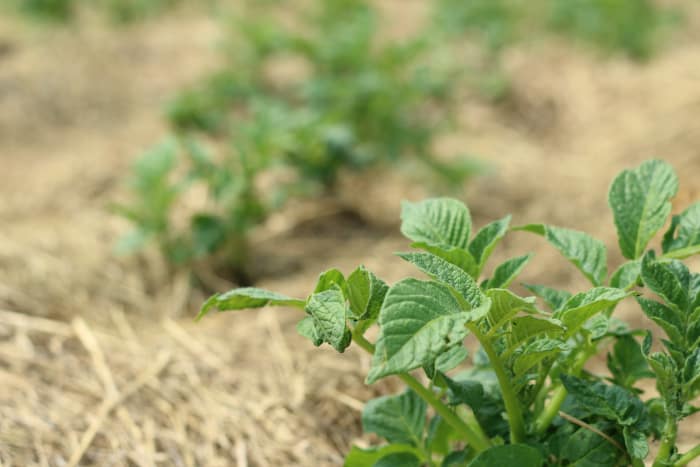
Potato Growing Maintenance:
Potatoes are pretty easy-going once they get started (another reason I love them), just keep a few things in mind:
- Occasionally check to make sure the potatoes are properly covered with dirt or mulch and not exposed to sun, which will turn them green.
- Keep an eye out for bugs. Aphids can occasionally be a problem, however, the main culprit is the Colorado potato beetle. You are almost guaranteed to get potato beetles, so try to get rid of them as soon as you see them. (They’ll also lay egg clusters under the leaves, so lift the leaves to check that too.) In the past I’ve paid my kids to pick potato bugs/eggs or my DIY organic pest control spray is a good option too.
On occasion, potato crops can be lost to late blight as well. I’ve not personally had to deal with this (yet!), but if you see black or moldy leaves, it’s possible you have potato blight. Remove and burn the damaged foliage and be sure to always use high-quality seed potatoes to attempt to avoid it in the first place.
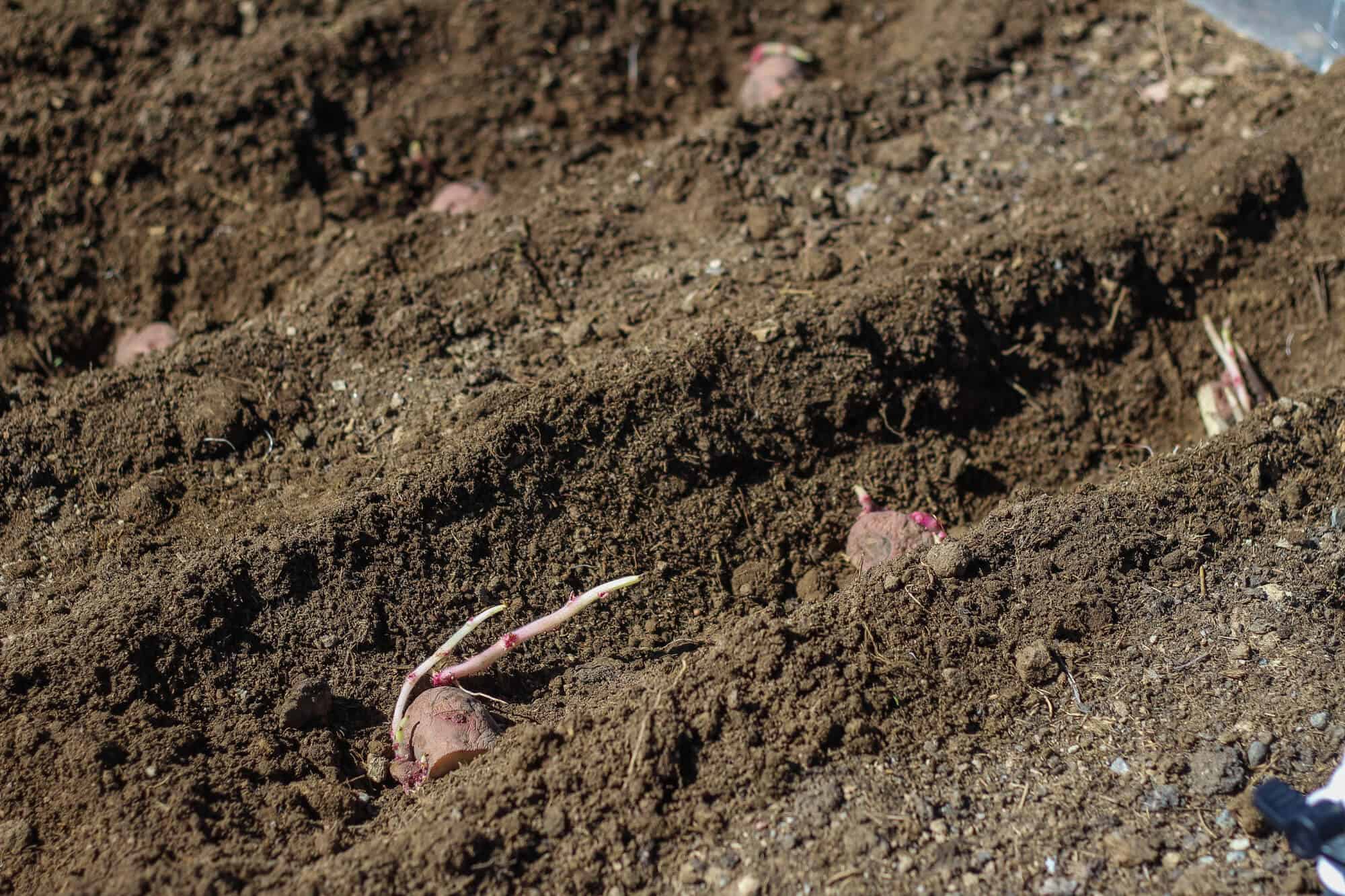
Harvesting Potatoes:
Once your potato plants bloom, you can start harvesting baby potatoes for immediate use. (These are the most tasty, in my opinion.) Some people use digging forks, but you can also just dig into the soil with your hands (that’s what I usually do…). Use caution as you dig to avoid damaging the roots of the plants, and be sure to leave some potatoes to mature for later.
If you are growing potatoes for storage, leave them in the ground for a few weeks after the leaves and stems turn brown and dry. This gives them a chance to thicken their skins for better storage. You can leave them in the ground as long as you want, really, just as long as you dig them up before your first hard frost. (You don’t even wanna know how many years I’ve been out frantically digging potatoes as a snow storm rolls in…) Do NOT wash your potatoes if you are going to store them. Just brush them off and call it good.
For storage potatoes, harvest them on a dry day and allow them to cure them for a few days before storing in a dark, cool, and well-ventilated place. They can last for up to 6 months in proper conditions.
I recently wrote a very thorough post just about harvesting potatoes. Click here to learn more about digging up and storing potatoes for winter use.
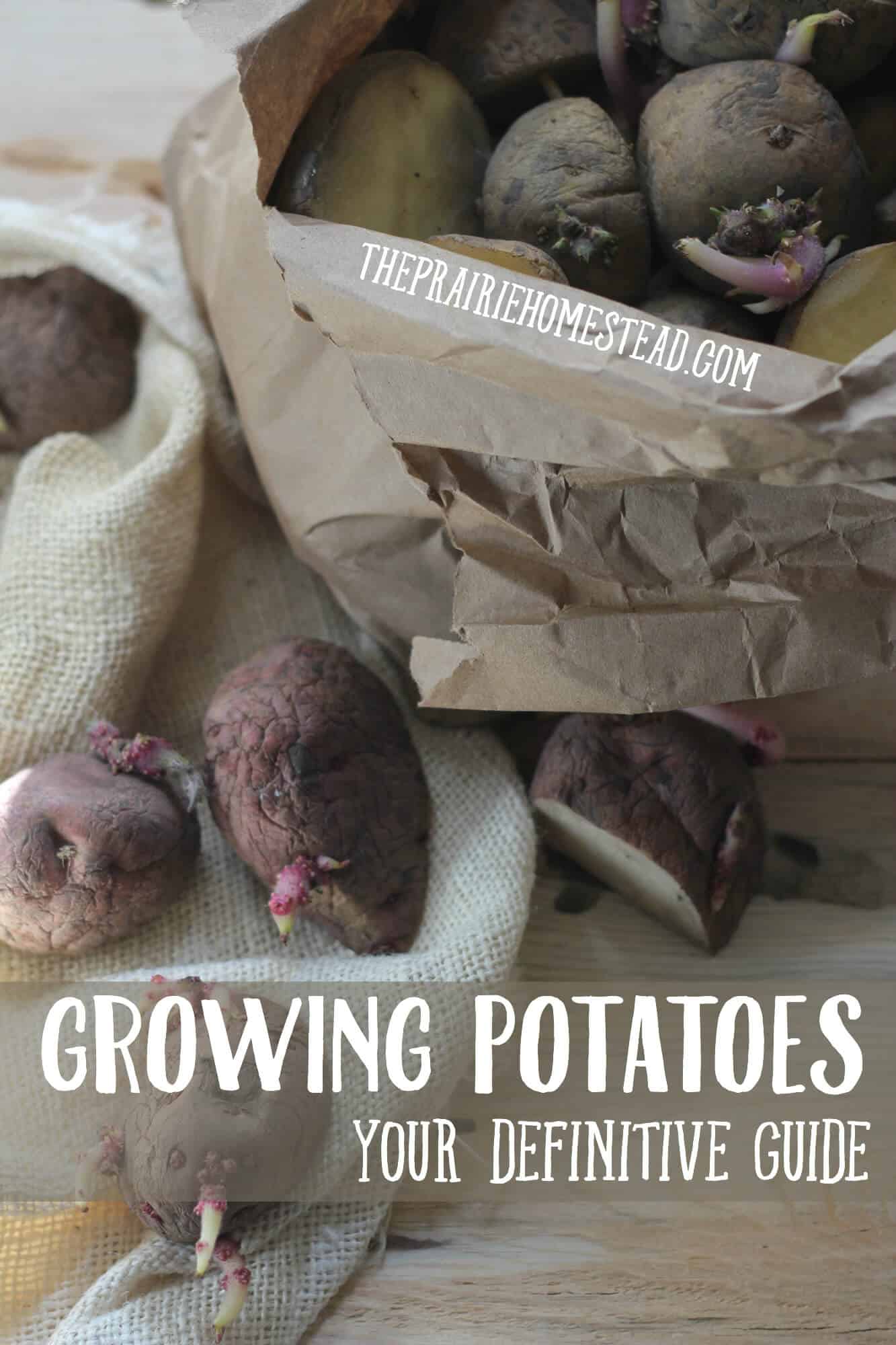
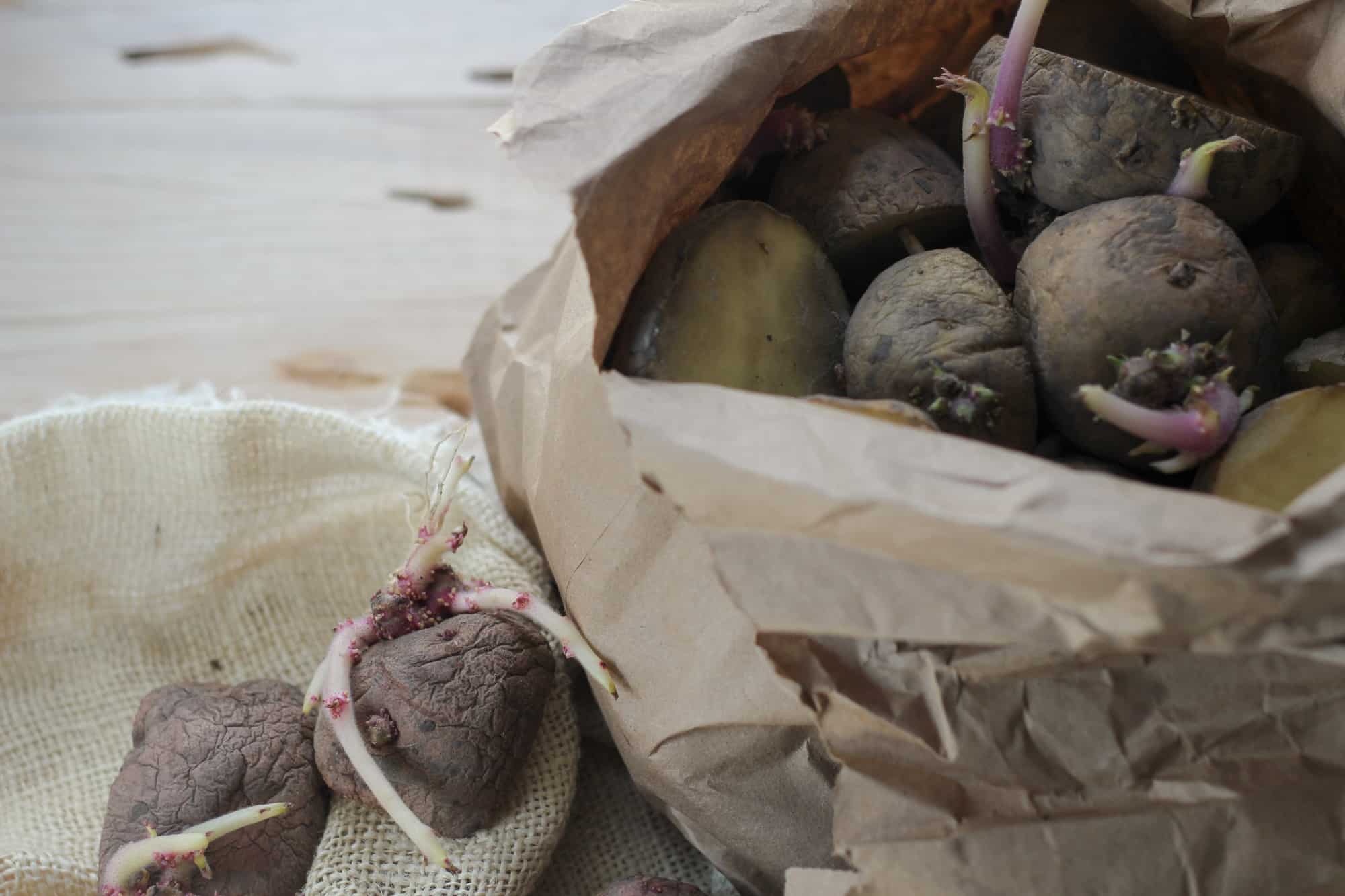
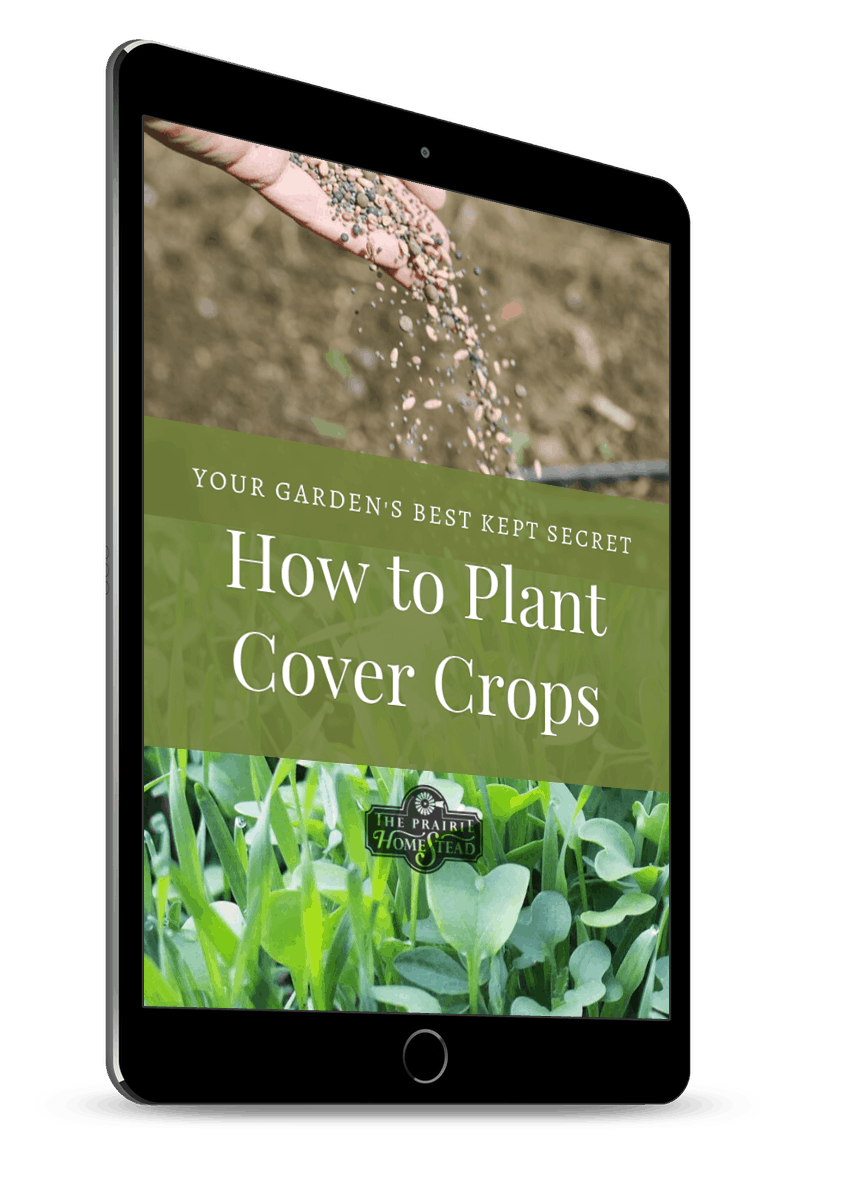

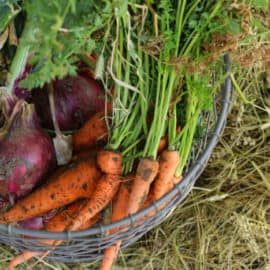


My great grandad always lined the trench for potatoes with wet newspaper to help with water retention.
I do the same thing now and plant on top of where I was trench composting. I’ve found potatoes are heavy feeders and I get a good crop doing this!
Mulching the hills helps forgetful gardeners from getting green spuds!
I’ve been growing potatoes for years and years.
2 things:
1. They are nothing like the grocery store dry spuds -homegrown taters are juicy, tender, delicious & will cook in half the time.
2. There is nothing fun about digging them up…. even though some say it is the best of times…
liars.
LOL
Great post. Love your new beds!
Happy Gardening!
cj
Amen and amen! 😉
I think if it like an Easter egg hunt. My husband helps me and we giggle and laugh like little kids-“oh! Look at these! Wow check this out!”
We love growing our own potatoes! I’ve had great success in towers made from welded wire fencing. We layer with a combo of dirt and straw as our ground space is limited. I adore your garden boxes and would love more space in my garden!
anestinthecity.com
Love the idea of wire fencing towers! And glad to hear the method is successful for you, too!
Macy I have never grown potatoes since I’ve been an adult and I was just wondering if you could please give me step by step on how to do a tower potato bed??? Plus how does the dirt not fall out of the tower bed??? Thank you
This year I have planted two different ways. I put some in large planters with fencing that I fill with oak leaves as they grow and two in mesh cat food bags. One didn’t make it, but I think that was due to pests. The other is the healthiest of them all. It just finished blooming and I think we will go harvest today.
I have read that you are not supposed to use Oak leaves in compost or your gardens. Don’t remember why.
It turns soil acidic
Last year I was told that potatoes could be started indoors in pots and then transplanted to the garden when it was warm enough. I have done that twice now, and it works. It gives a little bit of a head start if you have a short growing season. I’m in Alaska, and I have never had my potatoes “leaves and stems turn brown and dry”. They usually are green until the frost kills them!
That’s good to know! I never thought about transplanting them…
So I have a nice crawl space under house. I store my onions under there. Does that mean that I can’t store potatoes there also? It is large the whole house.
I understand potatoes will spoil if stored with onions or apples, the three need to be kept separate. It may be sufficient if you put up some sort of wall in your crawl space to create different rooms, if that’s possible for you ????? good luck!
When we were kids, we would go down to the creek and catch a whole bunch of small chubs & shiners. We would put a fish next to each potato then, cover the fish/potato with soil. We used to have some really good yields with this method and the flavor was awesome! Red Pontiacs were our preferred spud. They make great German potato salad!
As I understand things, with potatoes you’re supposed to stop watering them after they emerge from underground and grown some. Then 2 months from harvest, give them one good soaking and stop watering for good. Has anyone else heard of this? I do it every year with my potatoes.
Hmmm… I usually water all summer…
We’re trying sweet potatoes this year for the first time! Fingers crossed for a good harvest… (PS–This post sounds like Jill but I’m confused…who is Cris Daining?)
Love you, thank you for your blog
Thanks for another great article. I absolutely love growing potatoes! There is nothing like the taste of freshly dug potatoes from your own garden.
Been reading this blog on and off for several months now, am signed up for the newsletter (the only one I actually read from time to time). I wish I had found this sooner, and am resolved now to read as much as possible because there is so much useful, practical information-and it is so well organized and detailed. I have been disappointed in my garden because around late July each year I get overwhelmed. With the weeding-typically we get a real wet week in July and the weeds take over. Then I get discouraged, overwhelmed and depressed! I still get lots of great stuff but I know my downfall is lack of preparation. We’re gonna do it smarter this year and prepare it in the fall for the spring like we ought to have been doing-but your blog is basically going to be my go-to techical manual for pretty much the entire process, so, thanks so much for all the great info. Blessed be.
So glad to have you following along, Jen! And yes, preparation is so key, although it’s easier said than done, huh? 😉
Look into the Ruth Stout or Back to Eden or lasagna or no till methods of gardening. Basically use a thick layer or covering materials of choice or what’s handy. Join some Facebook groups that are based on these methods. You’ll learn so much.
Yeah for Back to Eden, and no-till. Also, Herrick Kimball of The Deliberate American blog is experimenting by using his mini-beds-on-plastic method. I want to try that this 2019 vegetable garden.
I haven’t grown potatoes yet but love to try don’t have space going talk to city Mayer see if I can put raised ones in the ally hope they let me use it. Can anyone tell me where to get great seeds to get the potatoes around here we don’t have anyplace to find stuff like that and also does anyone know if you can grow potatoes in winter in Oklahoma in southwestern Okla. Winters not that bad “sometimes” I just found this blog and I love it help me understand alot.
Some of the potatoes from our garden last year have sprouted and gotten leaves. Do you think they will grow potatoes if I plant them as my seed potatoes?
I reuse my potatoes each year and have not had any issues. I also sometimes use ones I have received from my CSA box. Then I know for sure they are good for the area. It has been years since I have purchased seed potatoes.
Ive always heard of people using tires. Ive never tried it myself. Ive just started gardening last year. Would tires be ok to use? Or would the chemicals in the tires leak into the plants?
The new snow tires for my truck were big and beautiful. The dealer said the old tires required a $2 charge each to dispose of them.
“Put them in the back of the truck.”
When I got home, I put one tire down and filled it with good garden soil. I added a bunch of subarized potatoes.
When they sprouted, I put the next tire on top and filled it with soil.
When the sprouts grew up again, down went the third tire and more soil. Finally the fourth tire was employed.
The potatoes grew and soon it was time to harvest.
I leaned against the tower of taters until it tipped over … and the harvest began.
I love this!
Did you water them often? I have a horrible problem of over watering plants.
This will be my first year growing potatoes. We have rock hard clay soil and a small backyard, so I’m using the potato tower method. You mentioned crop rotation, so I’m curious what to do next year, since the tower is the only real space I have for potatoes and I would like to grow again next year. Can soil amendments be used, or is there another reason for not planting the same crop in the same space?
Two years ago I tried growing seed potatoes in a container. I did the layering method, when I sae green, I put on more soil. But, I think I didn’t add enough amendments to our clay soil and got very little yeild. I am going to try again as I love homegrown potatoes!
purchase at Wood Prairie Family Farm, 207-429-9765 100% organic potato seed in Bridgewater, Maine, http://www.woodprairie.organic I’ve heard that it is best to plant potato sprouts 12 inches long. Also I’ve heard that you can grow sprouts after you remove them at a few inches long, right into a pan of potting soil or soil in your greenhouse or home where you minister some warmth and a growing light and of course, water, to them, and after frost danger, plant in your vegetable. Happy Gardening!!!!!! in 2019.
Last year we built 3 potato boxes from old pallets. We left vents on all sides by not stacking the side slats one on top of the next; it was great for drainage. Our soil in Michigan is sandy, so we layered the boxes with ground soil, purchased garden soil, straw, and peat moss. We had a bumper crop! I was concerned to read in your article about changing location yearly for growing potatoes. We had planned to use the boxes again this year (and in the future). Will let you know the outcome.
We also garden in raised beds. (Not contained, but raised none the less.) This is the method we use when planting potatoes because it causes no damage to the integrity of the beds and actually improves them: dig a deep trench in the middle of the bed and plant your spuds. Then as they grow, cover with compost. (Kind of like the technique for planting asparagus roots.) Not so much hilling but rather filling up the trench. After harvesting the spuds (which I do enjoy – takes me back to my childhood) we plant our garlic in that bed in October because it is fluffy and nutrient dense! Win, win!
I’ve had rather pitiful past attempts in my raised and or barrels back in Minnesota. The few we got were deliciously superior to store-bought. Now I live in So. Texas. I have everything in waist-high containers or pots on the ground. My tomatoes overwintered so are on their second harvest and most things are doing great, though fighting critters all the way.
I am trying the Potato Bin method which I made from chicken (or something) wire that I wrapped into a cylinder as closed with some cable ties. I lined the sides with hay to keep the soil in- no straw to be found ’round here-and have been adding compost and soil + throwing in some random seed and even wilted store-boughts of various varieties. Now I wait. No idea what’s in there. Some leaves had an ugly curl yet some were resistant to whatever caused that.
Amateur that I am with potatoes I can’t wait to dump it over with hopes of seeing more than 12 spuds this time, but have no idea. If it works, I’ll be bragging about it to this site and to whomever will put up with me.
Hi there!!! I got a quick question. When do you stop adding more soil/mulch ontop of the plants? I might try growing some in a bucket as part of your food security challenge!
I am growing in five gallon buckets this year. I started with around 4 inches of soil when planting. As the plant grew, I added more soil incrementally all the way to the top. Now we are blooming! I’m so excited to see what’s inside the bucket!!
hi, Jill. New gardener here. I decided to try grow-bag planting, but I did it all wrong. I planted about 12-18 seed potatoes in IKEA bag. They are quite lush but over-crowded. Could I dig them up and re-plant with more spacing or would that damage them?
Hi, Jill ! I liked your post. Good info. I wanted to let you know that because of space restrictions, I’ve been planting my potatoes on plastic totes ! (last couple of years) I use those really big totes with a lid. I have had great yields . In your totes, first drill some holes in it to the tote for drainage. Going up the sides about 2 inches. First layer in the tote is some pea gravel , about 2-4 inches. This is also for drainage. Then your soil/compost about 4 inches. Plant your potatoes. As they grow, add more soil/compost around them. Keep doing this until you are at the top of the tote. Then let them finish out, blooming, dying back etc… Leave them in the dirt( I just heard of this right now reading your post !) to harden off. Then, tip the tote over ! The dirt and potatoes spill right out ! We have a tarp ready to put them on. THis is so much better than trying to dig them up and then”forking” them, causing split potatoes, etc… This year, I’ve bought a couple more totes as I want to try growing Yukon’s and Purple majesty.(supposed to be a deep purple potato !) Thank so much for this post. I’m going to look at it often during this growing season !
That sounds awesome Kathy! Thanks for sharing your experience!
Awesome idea Kathy! Just to confirm, when you say totes, do you mean something like a 5-gallon bucket?
Thank you!
I think that probably depends on how old they are. If the plants are pretty small, go ahead and try! Otherwise you may just shock them.
I have hilled twice with soil and the tops are still growing like crazy. Can I switch to mulch? And what is considered mulch? Wood chips? Traditional mulch? Straw? Hay? Also, they are starting to flower. That’s normal, right? Not a sign of bolting?
Do you cover the green leaves from the potato plant when you are chilling them? Signed, A Newbie!
How do you store them? I say this knowing my parents would never wash them, just put up in root cellar covered in dirt. I have seen 10 yr old potatoes stored this way that were perfect.
Though I skimmed this article, you should address storage, if you would.
Thanks.
Somewhere in (late) autumn last year I put a couple of pieces of store-bought potatoes (probably Colombas) that had started to sprout and rot into the ground – and completely forgot about them.In early spring, I was surprised about a few vigorous plants that showed up in a plot where I tried to start another crop. After checking with a friend I was happy that I’d left the shoots alone, and I’ve been rewarded with 2 meals of absolutely delicious hasselback potatoes. We’ve got very rich and heavy clay soil here, I was surprised to get such big, healthy taters out of it! I’ve since learned from a local farmer that less well-to-do people would actually save the peels with eyes and plant those to grow new potatoes!
I love what your doing with your garden ,mine is terrible each year, the squirrels did up everything ,i tried all the tricks to deter them, need help, plz. thankyou colleen
Sorry to hear that! I wonder if liquid fence would help keep the squirrels out? https://www.theprairiehomestead.com/2015/06/homemade-liquid-fence-recipe.html
Different things work in different places. I’ve had good results from powdered coyote urine that you can buy in hardware stores.
Also, cats. Encourage a barn-cat/stray to hand around by feeding them just appetizer-level. If they want a real meal, they have to hunt. Failing that, if you have a beloved indoor cat, or your friend does, sprinkle some peed-on litter around the yard perimeter. Not right near the garden and not even enough to smell. The squirrels can smell it and don’t want to become lunch.
My family knows not to mention the film “The Martian” in front of me unless they *want* a hearty lecture. The way he grew those potatoes was 10 different kinds of wrong; which was a moot point bc there’s no way they would have survived a 10 month trip to Mars without being dowsed with sprout inhibitor. While vacuum-sealed in suffocating plastic, no less. And the guy was supposed to be a botanist! ?
Made me crazy.
Haha, true enough!
we have grown potatoes in containers for several years now, and get a decent harvest – there is just my husband and myself, so don’t need a huge crop. We use plastic, 50 gallon containers, cut in half, and sit them beside our regular garden (which is about 10′ x 12′). A hole cut in the side helps drainage. In northern Pennsylvania we have a lot of hills, and our house is on the shady side of the valley, so we don’t get sun until afternoon. The potatoes grow all summer, and we usually harvest in late September. Our growing season is short – starts the first of June, so the potatoes vary in size. But its fun to watch them grow!
That’s awesome! Way to find a way to get it done!
The best time to plant potatoes in South Carolina is around February 1 – March 31 in the Coastal region and March 15-April 20 in the Piedmont, when the soil temperature is 45-50°F.